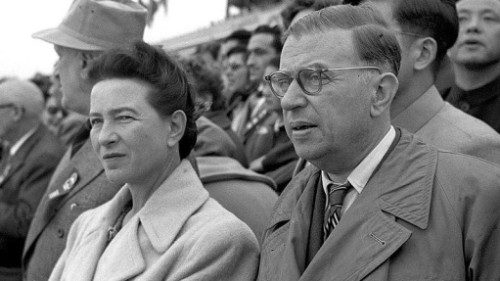
The itinerary of Raïssa and Jacques Maritain
Raïssa Oumançoff and Jacques Maritain are undoubtedly one of the most famous European couples of the twentieth century. It is difficult to place them in a particular narrow circle, because their interests and influence are extremely broad.
Raïssa (1883-1960), who was a Russian Jew, and Jacques (1882-1973), a Frenchman from a Protestant family, met in 1900 during their university studies in Paris, at the Faculty of Science. Jacques, who had already graduated in philosophy and Raïssa were both deeply dissatisfied with contemporary philosophy, characterized by skepticism and relativism.
Thus began a long journey of sharing that would end only in 1960 with Raïssa’s death, which unfolded through several significant stages.
In 1904, Raïssa and Jaques married in a civil ceremony. However, the real turning point came about in 1905 with their conversion to the Catholic Church, followed by baptism in 1906. This was thanks mainly to the influence of Charles Péguy and the philosophy of Henri Bergson, after their decisive meeting with the novelist Léon Bloy.
From then on, Raïssa and Jacques shared all the important moments of an eventful life that took them to the United States, Canada and back to France. From 1945 to 1948, Jacques was appointed ambassador of France to the Holy See.
When his wife died, Jacques withdrew to the Community of the Little Brothers of Jesus and, in 1971, he himself became a Little Brother.
It is possible to identify three lines, which are so closely connected that only for ease of exposition is it possible to separate them, along which the path of the Maritain family unfolded: that of mutual love, that of faith, which both sought and found, and that of the common search for truth.
A poet and mystic, Raïssa’s love, and Jacques, a philosopher and essayist, touched all dimensions of their existence and, according to the testimony of those who knew them, it was diffused, that is, capable of radiating out and involving others in a network of deep friendships, and spiritual and intellectual confidence.
It has been said that the lines of the Maritain’s existential experience are intrinsically connected. In fact, it is impossible to speak of their mutual love without taking into account the path that led them together to the Catholic faith that constituted the luminous beacon of their entire lives.
The faith had snatched them away from the nihilism and pessimism that was then prevailing in French culture and philosophy, and fidelity to the Catholic Church, despite its then obvious defects, consistently accompanied them in a strong and never denied feeling of convinced belonging.
The third line is that of the constant and shared search for truth, which had been satisfied by faith, but continuously deepened with a continuous aspiration to further clarification.
This is where the encounter with the philosophy and theology of St Thomas entered their lives. His thought opened up new horizons by indicating that there is no contradiction between faith and reason. In addition, that the whole of contemporary thought, even with all its problems, can be considered in a superior light that reveals its often hidden and concealed potential.
For Maritain as well, St. Thomas’ is the “perennial philosophy”. However, it did not annul all the other conquests through thought, which in different ways, were often convoluted, and tended towards a truth that, in itself, was always inexhaustible.
When thinking of Raïssa and Jacques Maritain, our thoughts spontaneously turn to the other great couple of the French twentieth century, Simone de Beauvoir (1908-1986) and Jean Paul Sartre (1905-1980), who followed an existential path light years distant from that of the Maritains.
They instead were a free couple, who were open to other relationships, yet never cohabited. Theirs was without any bond of mutual fidelity, but only of absolute sincerity: de Beauvoir and Sartre shared a life experience in which the main glue was that of intellect and the aspiration to an absolute freedom without conditioning.
It would be easy to approach these two couples by using the opposition of transcendence (Maritain) and immanence (de Beauvoir and Sartre), but, in reality, the issue is more subtle. The transcendence in both couples, was vertical for Maritain and horizontal for de Beauvoir and Sartre.
For the former, vertical transcendence is that of the shared turning to a God who transcends both and draws them into his spiral of love; for the latter, it is the horizontal transcendence of the inappropriability of the other who always remains within himself, despite there being love.
Up to this point there is a possible comparison, but going further, one would only have to note the impossibility of a true comparison between the two couples who, each in their singularity, exerted an enormous influence on successive generations that is still felt today.
by Giorgia Salatiello













 Purchase the Encyclical here Fratelli Tutti
Purchase the Encyclical here Fratelli Tutti
